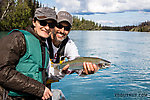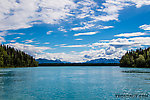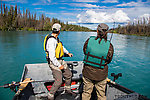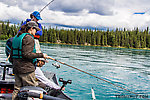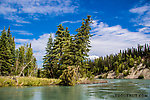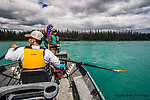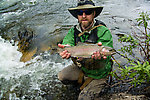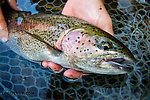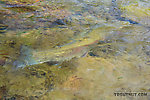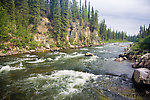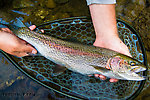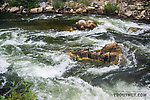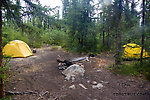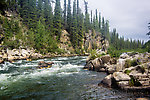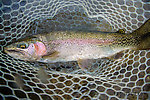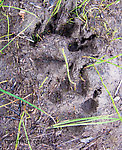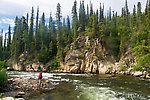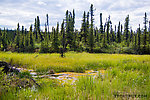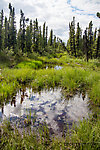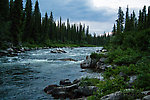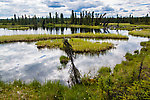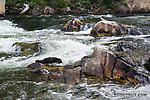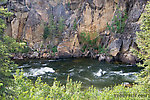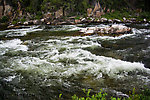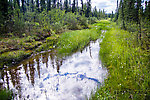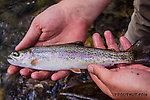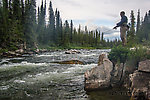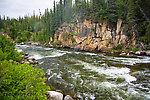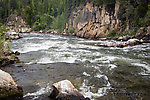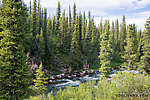Blog & Latest Updates
Fly Fishing Articles
Insects by Common Name


Latest updates, page 26
Beautiful day on the Kenai River with Corsetti's Guide Service
I mentioned in a previous post that my friend and coworker Sierra's father started a guide service on the Kenai River this summer. Lena and I were down in the area in late June and took them up on an offer to go out fishing.
Following a winter of heavy snowpack and a recent spell of hot weather, the middle Kenai River was about three feet higher than normal, well up into the streambank trees.
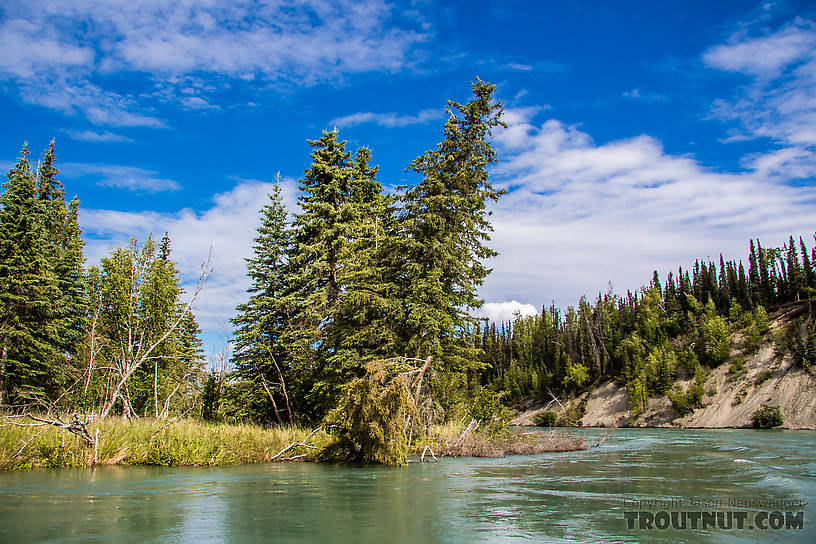
Fishing from the bank was out of the question anywhere along the river, as all the gravel bars were inundated, but it was very comfortable fishing from Perry's new power drift boat using a mix of spin and fly gear.
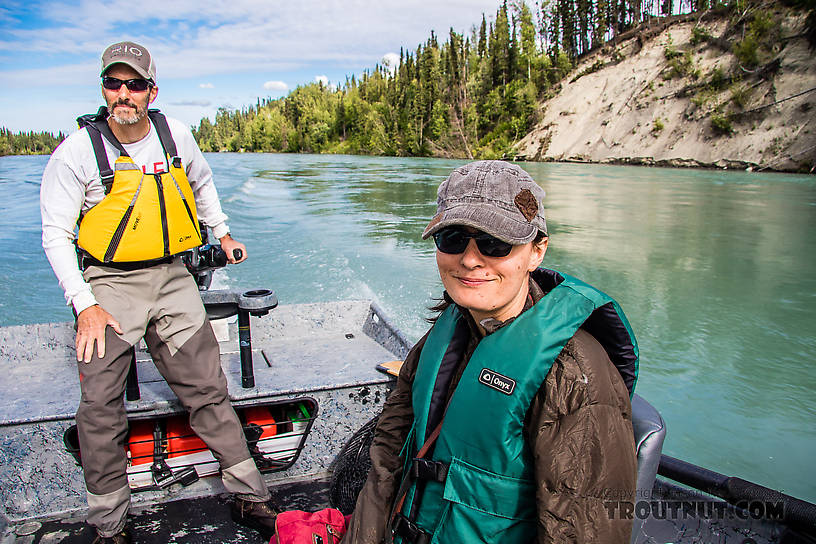
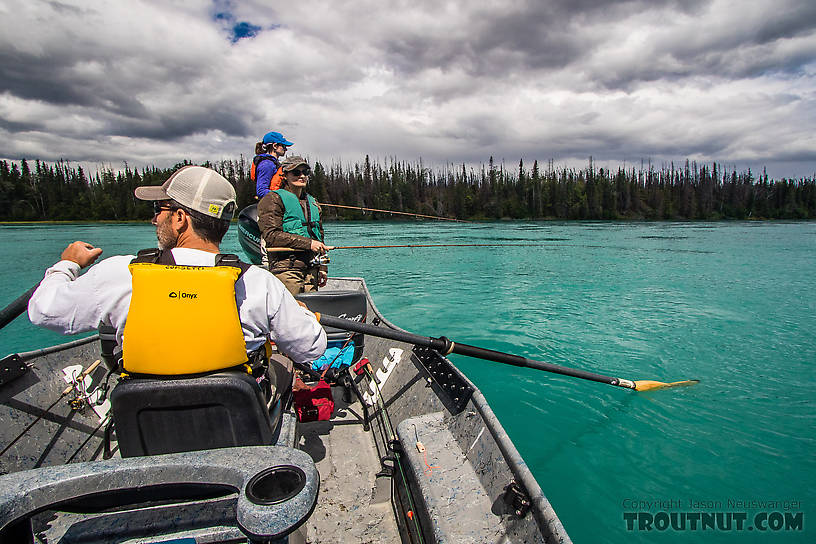
Despite the really high water and starting--at our request--later in the day than would have been ideal for the fishing, everybody still caught trout.

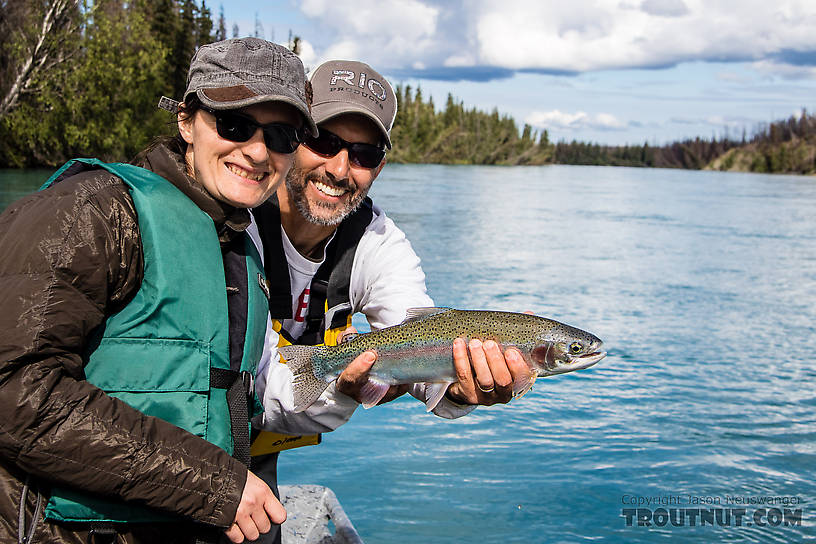
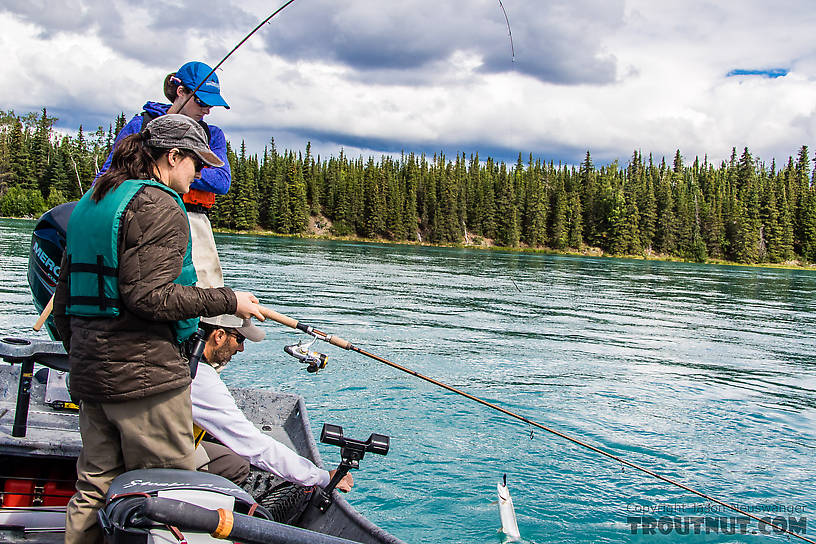
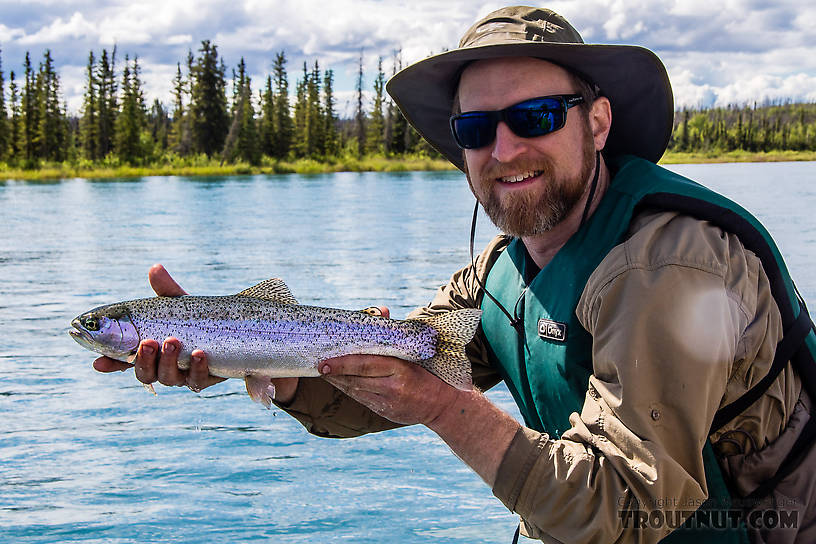
Even if we hadn't caught fish, the scenery and company alone would have made for a great day on the water.
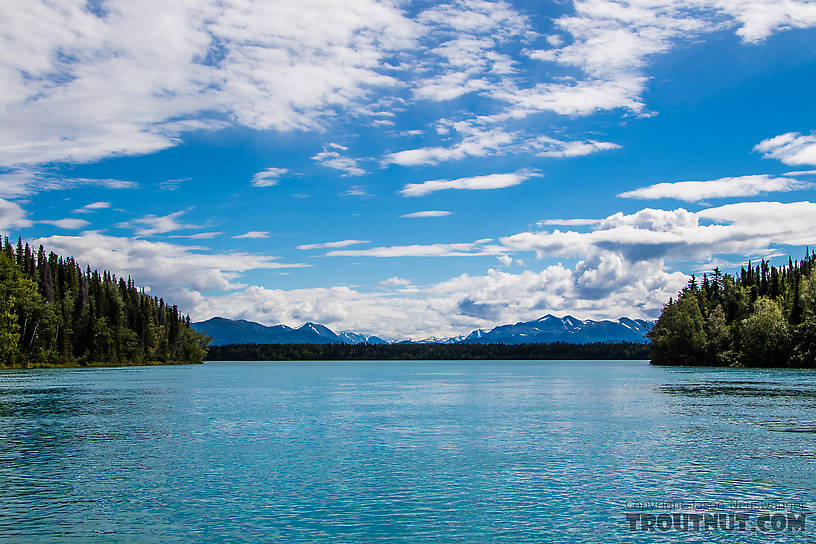
Thanks for a great trip, Perry and Sierra!
Following a winter of heavy snowpack and a recent spell of hot weather, the middle Kenai River was about three feet higher than normal, well up into the streambank trees.

Fishing from the bank was out of the question anywhere along the river, as all the gravel bars were inundated, but it was very comfortable fishing from Perry's new power drift boat using a mix of spin and fly gear.


Despite the really high water and starting--at our request--later in the day than would have been ideal for the fishing, everybody still caught trout.




Even if we hadn't caught fish, the scenery and company alone would have made for a great day on the water.

Thanks for a great trip, Perry and Sierra!
Photos by Troutnut from the Kenai River in Alaska
Putting the 'nut' back in Troutnut, Part II
This post is a continuation from Part I.
Using the same techniques I figured out the previous night, the action in the morning was even hotter. Pools that seemed fishless when nymphing the previous evening came alive.

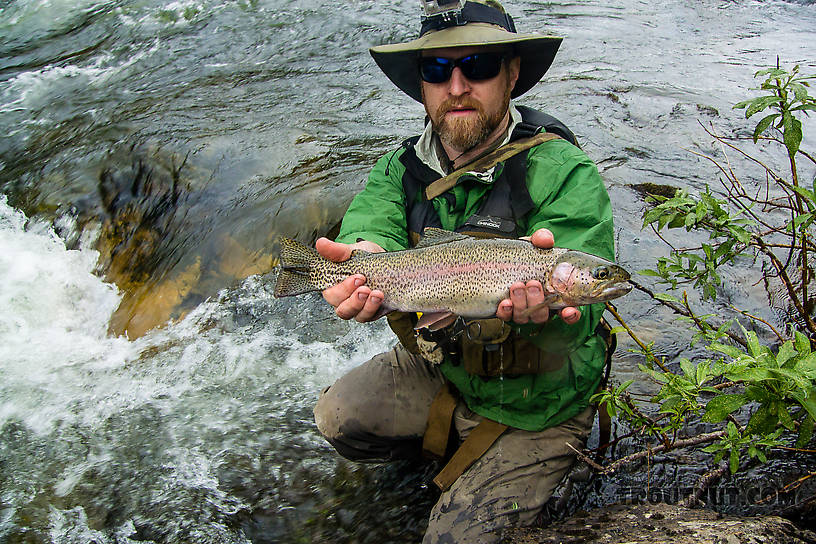
Swinging the streamer through the calmer spots amidst the whitewater brought violent strikes in which big rainbows, flashing silver and red and gold sides, rocketed into the air and cartwheeled back into the river with a big splash. For a brief, beautiful hour, almost every cast drew one of these spectacular strikes.
Hooking fish was the easy part. These were strong, wild, fast-water fish that see a lot of pressure, and they knew what to do when hooked. Every fish I hooked over 20 inches tore off downstream into the maelstrom while I desperately tried to keep up, clamoring over the boulders on the edge of the stream, blocked in by brush on the bank side and whitewater on the other. The drag on my Hardy large arbor reel screamed as these big fish turned their sides to the raging current and shot off toward the ocean. The first few fish wrapped my line up in the rocks or got so far downstream they could easily turn back upstream and spit the hook. I lost the first few big ones.
Finally, one of these fights went my way, and I landed this 21-incher:

A pretty 18-incher soon followed:
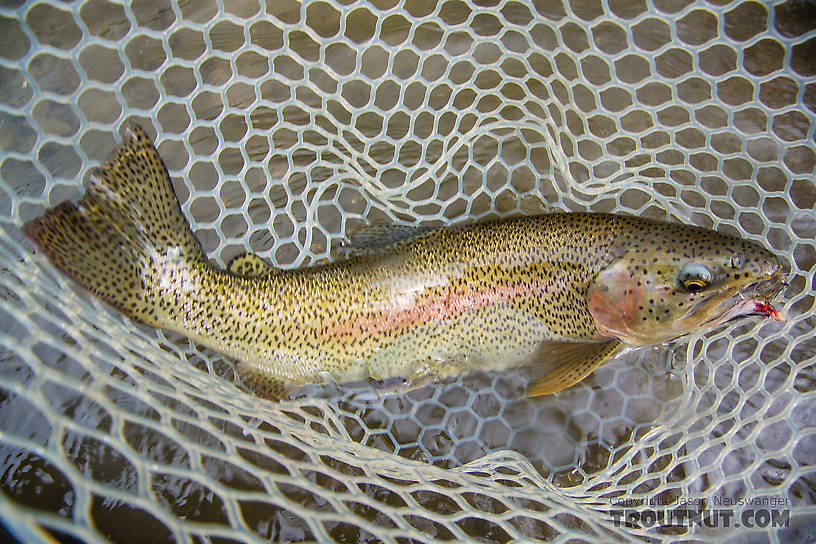
Josh was seeing some action on rainbows, too. But it was hard to communicate over the roar of the whitewater.
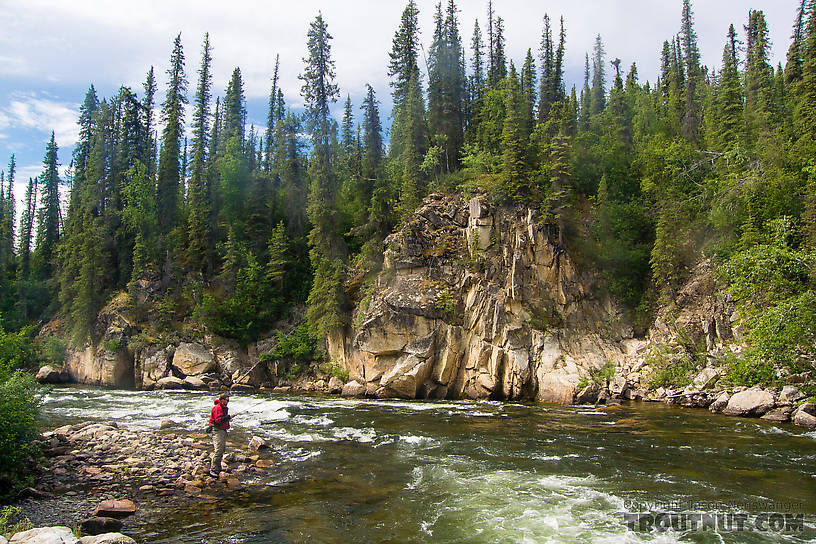
He had never caught a really big trout on the fly, and a main goal of the trip was to get him into one. He had hooked and lost a nice one the night before. Out of pure good luck, I was nearby with the camera when he hooked into a 20-incher in the morning. I wasn't quite close enough to help with the landing net (his was lost to a tree during the hike in), but he skillfully landed it without one:
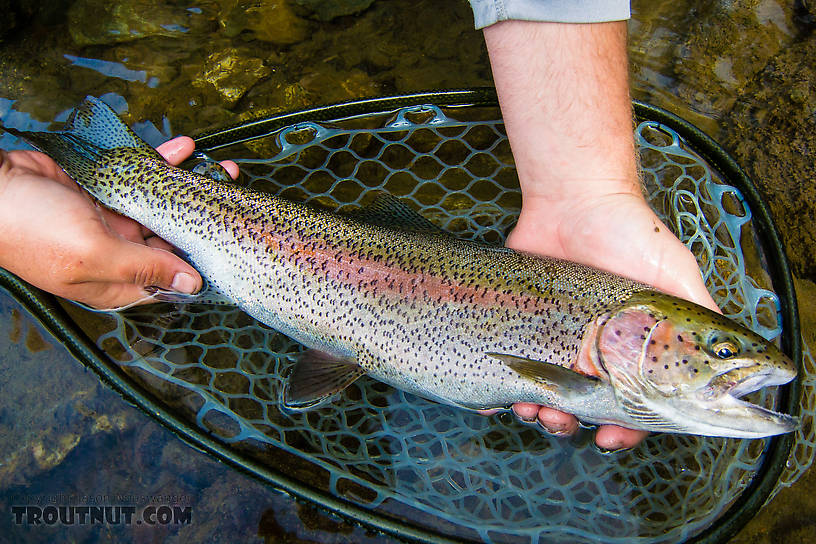
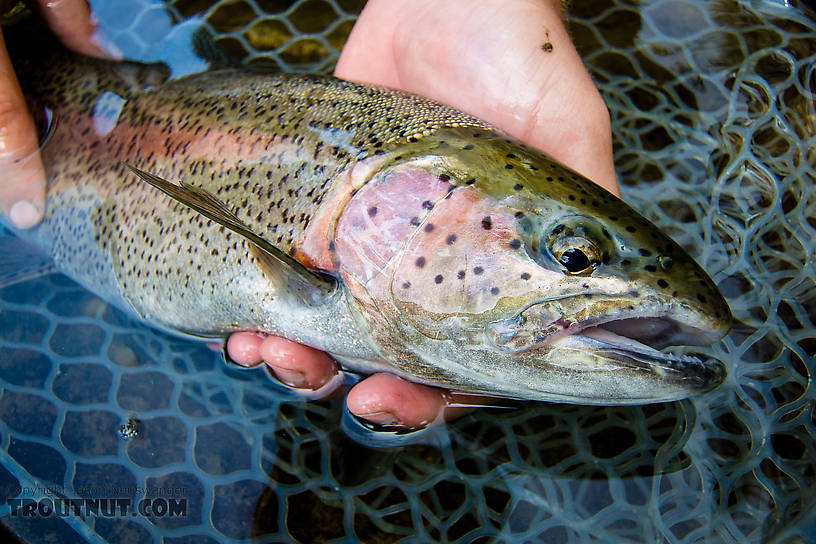
As we reached midday, the action slowed. But there was one spot I knew there were fish I hadn't caught. Earlier I had somehow dropped a fly into the dark water behind the far boulder in the picture below, and a rainbow immediately chased it, but the whitewater in the middle grabbed my line and yanked the fly away.
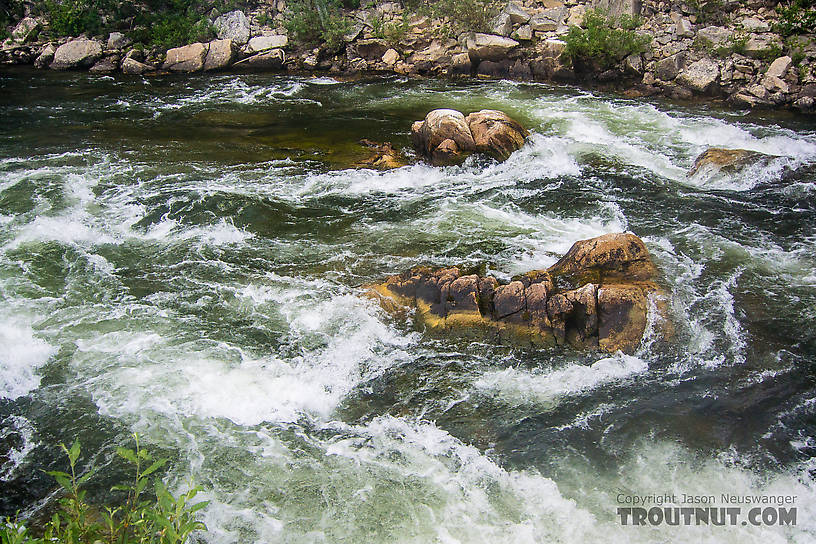
It was about a 75-foot cast, and I've never had much practice casting long distances -- let alone throwing a streamer and split shot with my 5-weight, and obstacles to the backcast. But this would be as good a time as any to learn. I stood atop the rock for probably an hour, working on my technique.
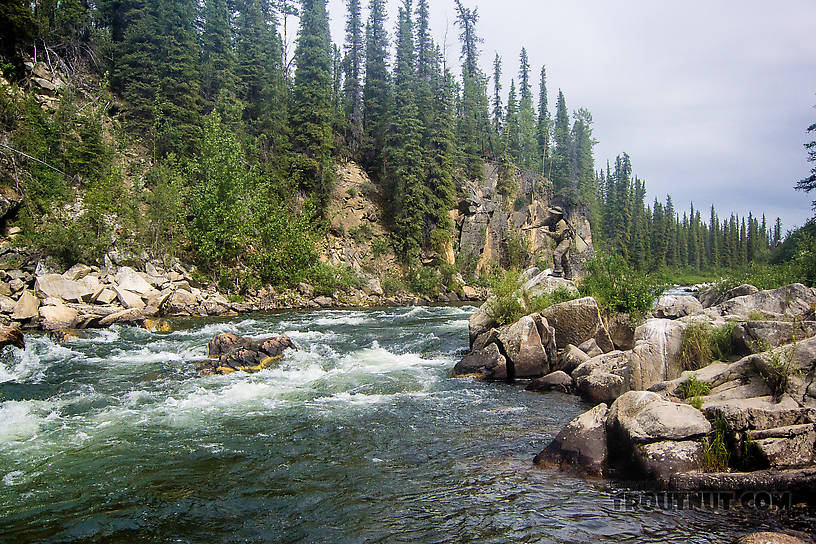
At first, maybe one in every ten or fifteen casts found its mark, and the fly swam through the target zone for a second or two before being ripped out by the current in between. Almost every time it did, the trout chased, and every time they did, they missed, often by the narrowest of margins. The first trout I'd seen in that spot was just a small one, 14 inches or so, but one of the first good repeat attempts drew out a monster. It made multiple follows and even aerial acrobatic attacks on my fly that never quite connected.
Eventually I improved my casting to 1 in 5 or so finding its mark, and I hooked the 14-incher. It fought like a fish twice its weight in the current, and was the most rewarding fish of that size I'd ever landed. Eschewing any chance at easier fish in other pools, I returned to trying for the big one.
After an hour or so, half my casts were landing, and half of those were drawing missed strikes. Finally, I connected! The big rainbow leaped into the air and then shot off into the same fast water that kept me from hooking it for an hour. The few remaining feet of fly line peeled off my reel into the backing, and I jumped down off the boulder to pursue. But I never had a chance. It was a fitting end to this trip that the big fish won the day. But I've never had so much fun losing a fish in my life.
Using the same techniques I figured out the previous night, the action in the morning was even hotter. Pools that seemed fishless when nymphing the previous evening came alive.


Swinging the streamer through the calmer spots amidst the whitewater brought violent strikes in which big rainbows, flashing silver and red and gold sides, rocketed into the air and cartwheeled back into the river with a big splash. For a brief, beautiful hour, almost every cast drew one of these spectacular strikes.
Hooking fish was the easy part. These were strong, wild, fast-water fish that see a lot of pressure, and they knew what to do when hooked. Every fish I hooked over 20 inches tore off downstream into the maelstrom while I desperately tried to keep up, clamoring over the boulders on the edge of the stream, blocked in by brush on the bank side and whitewater on the other. The drag on my Hardy large arbor reel screamed as these big fish turned their sides to the raging current and shot off toward the ocean. The first few fish wrapped my line up in the rocks or got so far downstream they could easily turn back upstream and spit the hook. I lost the first few big ones.
Finally, one of these fights went my way, and I landed this 21-incher:

A pretty 18-incher soon followed:

Josh was seeing some action on rainbows, too. But it was hard to communicate over the roar of the whitewater.

He had never caught a really big trout on the fly, and a main goal of the trip was to get him into one. He had hooked and lost a nice one the night before. Out of pure good luck, I was nearby with the camera when he hooked into a 20-incher in the morning. I wasn't quite close enough to help with the landing net (his was lost to a tree during the hike in), but he skillfully landed it without one:


As we reached midday, the action slowed. But there was one spot I knew there were fish I hadn't caught. Earlier I had somehow dropped a fly into the dark water behind the far boulder in the picture below, and a rainbow immediately chased it, but the whitewater in the middle grabbed my line and yanked the fly away.

It was about a 75-foot cast, and I've never had much practice casting long distances -- let alone throwing a streamer and split shot with my 5-weight, and obstacles to the backcast. But this would be as good a time as any to learn. I stood atop the rock for probably an hour, working on my technique.

At first, maybe one in every ten or fifteen casts found its mark, and the fly swam through the target zone for a second or two before being ripped out by the current in between. Almost every time it did, the trout chased, and every time they did, they missed, often by the narrowest of margins. The first trout I'd seen in that spot was just a small one, 14 inches or so, but one of the first good repeat attempts drew out a monster. It made multiple follows and even aerial acrobatic attacks on my fly that never quite connected.
Eventually I improved my casting to 1 in 5 or so finding its mark, and I hooked the 14-incher. It fought like a fish twice its weight in the current, and was the most rewarding fish of that size I'd ever landed. Eschewing any chance at easier fish in other pools, I returned to trying for the big one.
After an hour or so, half my casts were landing, and half of those were drawing missed strikes. Finally, I connected! The big rainbow leaped into the air and then shot off into the same fast water that kept me from hooking it for an hour. The few remaining feet of fly line peeled off my reel into the backing, and I jumped down off the boulder to pursue. But I never had a chance. It was a fitting end to this trip that the big fish won the day. But I've never had so much fun losing a fish in my life.
Photos by Troutnut from the Gulkana River in Alaska
On-stream insect photos by Troutnut from the Gulkana River in Alaska
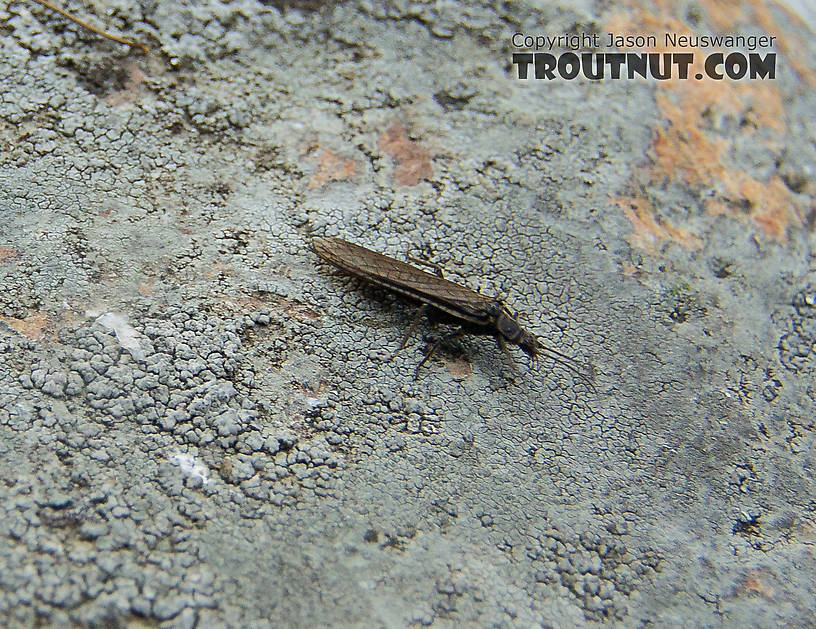
I'm not positive on the ID on this one -- I can't see the defining characteristics well enough to confirm.
This is a female. Males of the same species in the area had very short wings.
This is a female. Males of the same species in the area had very short wings.
StateAlaska
LocationGulkana River
Date TakenJun 24, 2016
Date AddedOct 26, 2016
AuthorTroutnut
CameraNIKON 1 AW1
Putting the 'nut' back in Troutnut
Last month I realized it had been too long since I did something ridiculous to catch some trout. So I recruited my friend and summer fieldwork crew member Josh to go chase big rainbows in a well-known spot on the Gulkana River. However, this well-known spot is really accessible only to people doing the 4- to 5-day float trip from Paxson Lake to Sourdough Landing, and we only had time for an overnight trip and no boat.
Various government brochures speak of a six-mile trail, the Haggard Creek Trail, leading from the Richardson Highway to this spot on the river, Canyon Rapids, a half-mile of raging Class III-IV whitewater that most floaters have to portage, or at least portage their gear and run with empty boats. One online source warned that the trail can be "a bit swampy," so I warned Josh with that caveat -- "It might be a bit swampy."
This video of the trip shows what they meant by that (and the fishing afterward):
Yeah, just a bit swampy.
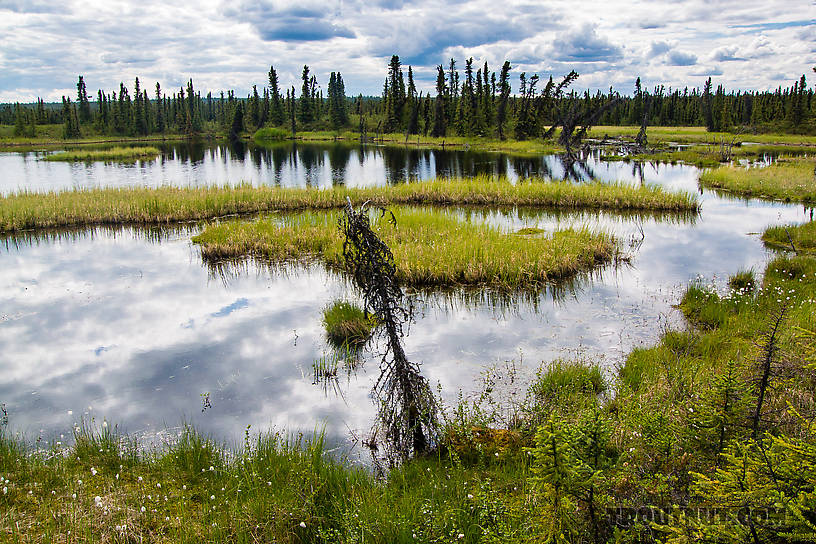
To be fair, the lakes were actually to the side of the trail. This was the actual trail:
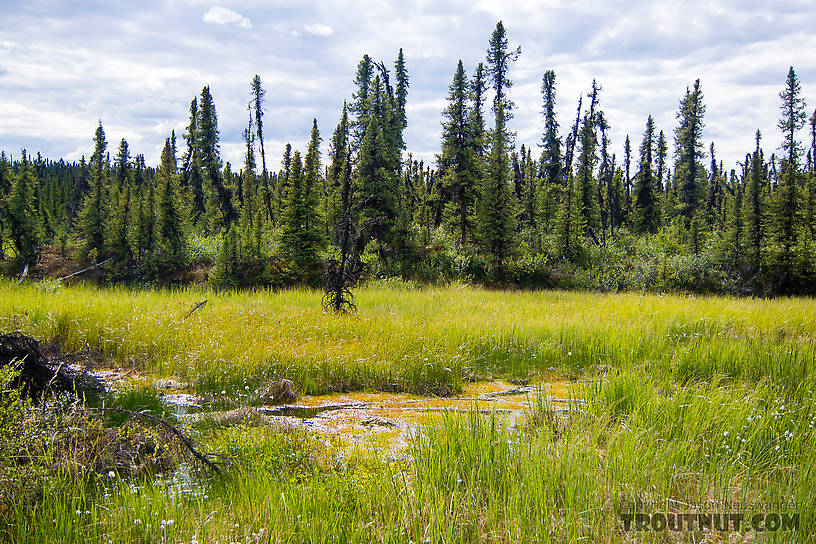
This, too:
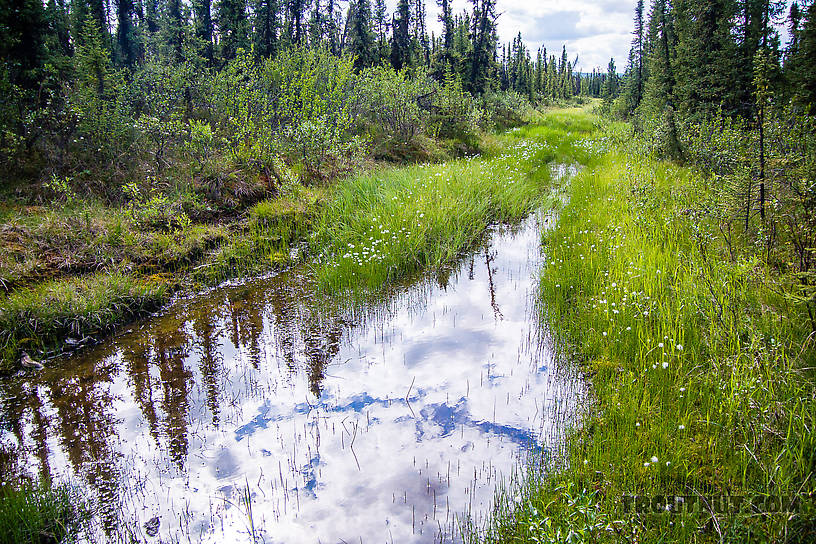
The mosquitoes were as bad as I've ever seen them anywhere in Alaska except the North Slope. This was typical:
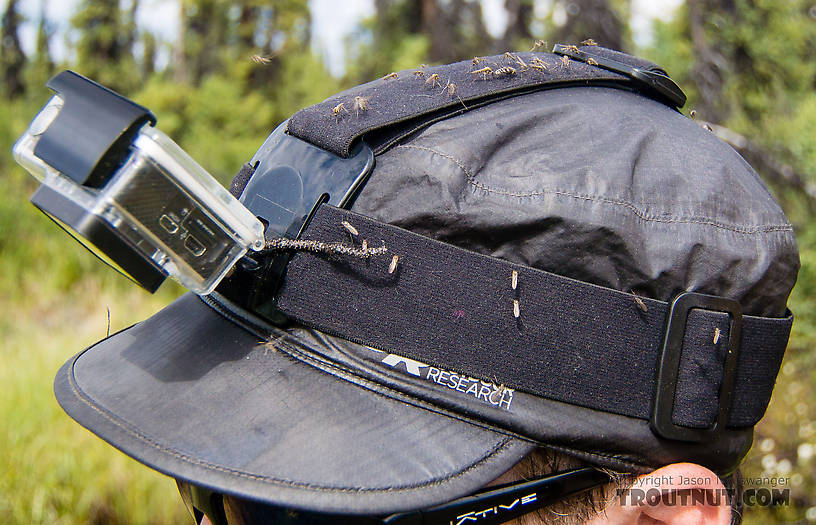
Most of the trail was hard to even find, let alone follow. It's really a winter trail. In the summer it's mostly untracked bog, with the "trail" frequently opening up into larger boggy meadows in which the trail's exit is unclear and no walkable route is apparent. I relied on coarse aerial imagery on my GPS to let me know when we'd wandered too far from the supposed trail in one direction or another. It reminded me of the scene below, but with trout at the end instead of Mordor. And my guide kept quiet instead of coughing out, "Garmin! Garmin!"

After five hours in the swamp, the sound of running water was a great relief, followed by this view:
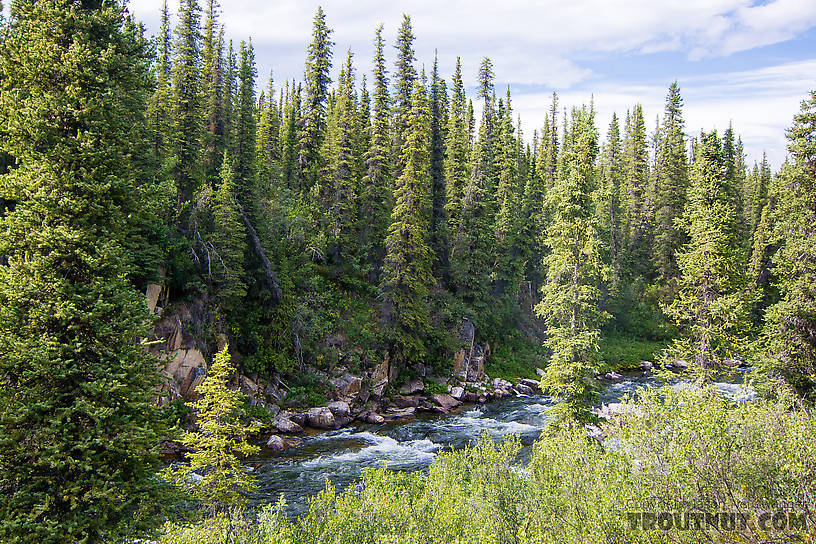
We set up camp at one of the nice campsites used by the heavy raft traffic ("heavy" means at least a few parties per day here):
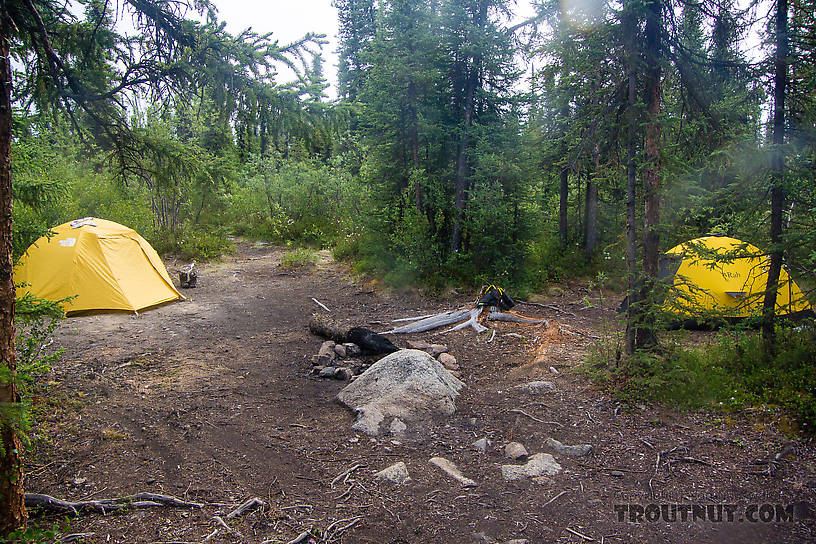
Then got to fishing the whitewater:
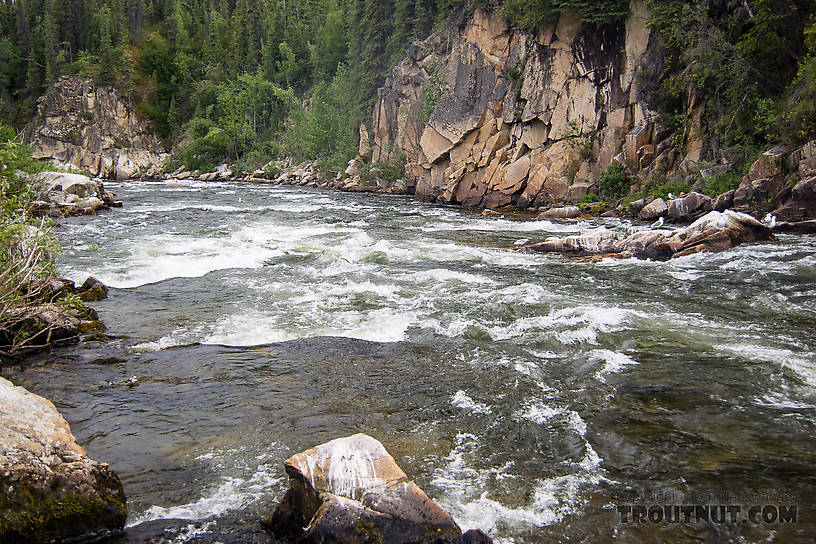
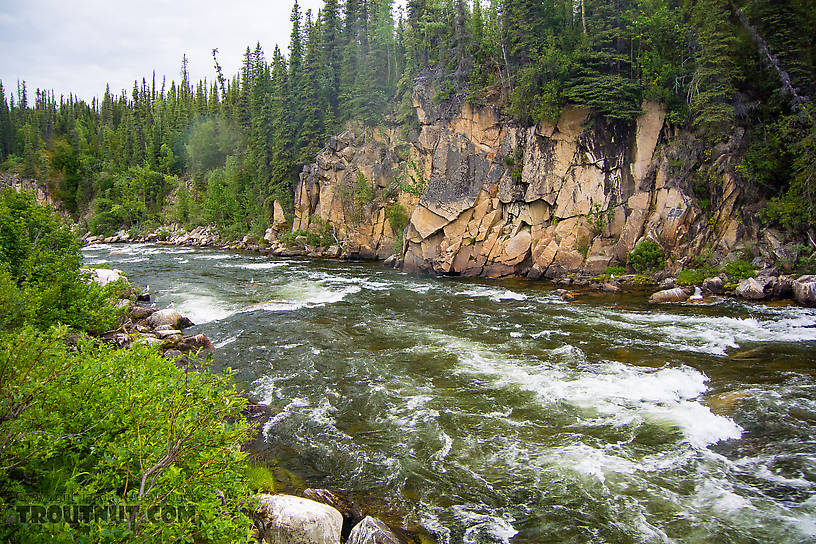
When we began fishing mid-evening, fishing nymphs under indicators, we mostly just caught small 10-15" grayling. Dozens of them. Fish on every cast at times. But there was little sign of the big rainbows we came for. The nymphs just picked up some little ones, like this:
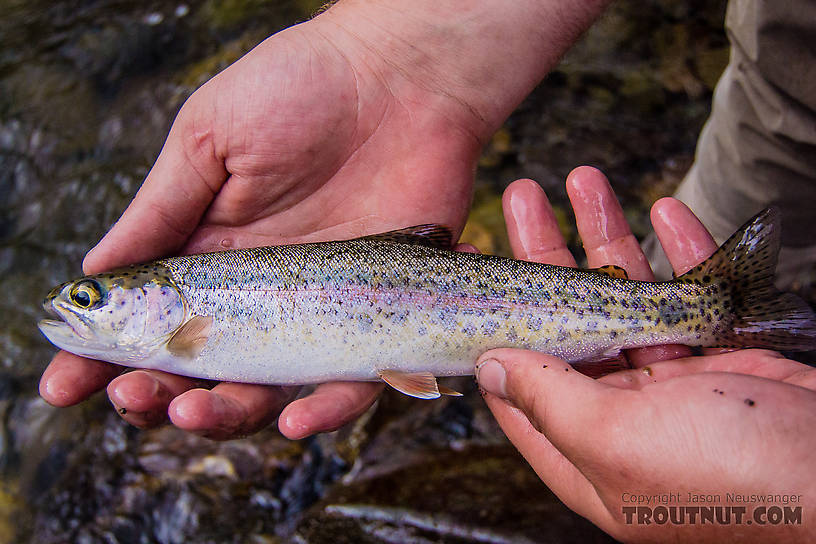
There were a lot of seagulls around, and I watched them as I fished, curious about why they were here. There were salmon in the river, both reds and kings, but we didn't see many, and no dead ones yet for the seagulls to peck at. What drew them to this spot?
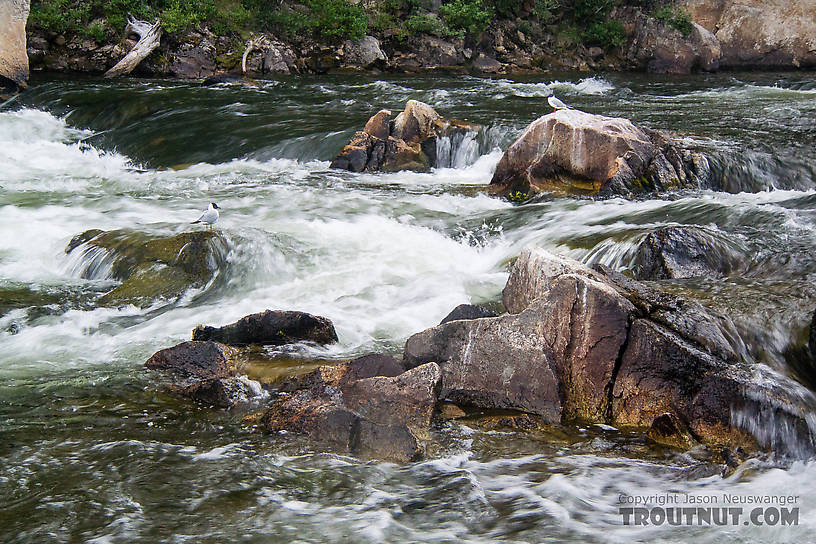
After a while I figured out the gulls, and with them, the rainbows. Finger-length sockeye salmon smolts were outmigrating from Paxson Lake upstream. When they hit the roiling whitewater of the canyon, some of them got momentarily disoriented and boiled up to the surface. That's when the gulls would swoop down and grab them. I figured the rainbows, which had been largely ignoring our nymphs, might be doing something similar. So I put on a silvery streamer and the real fun began.
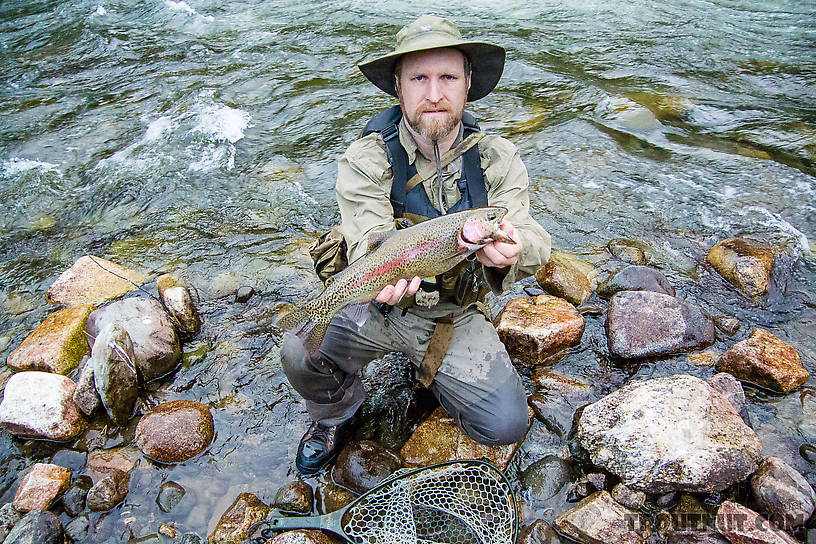
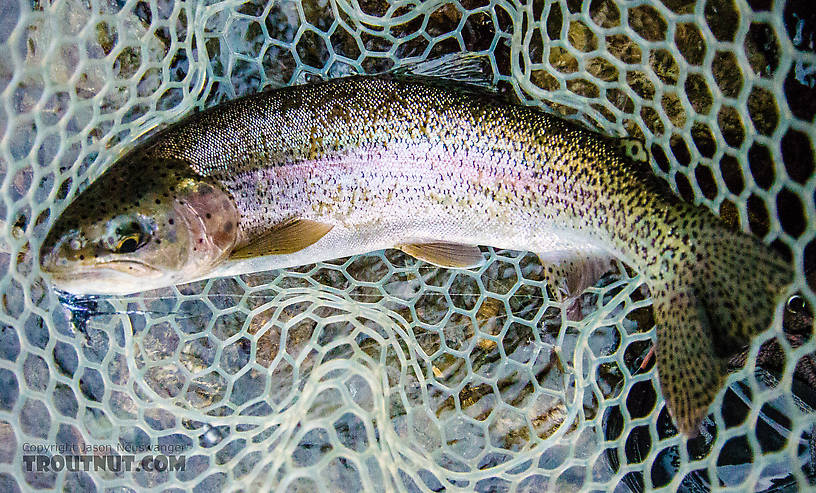
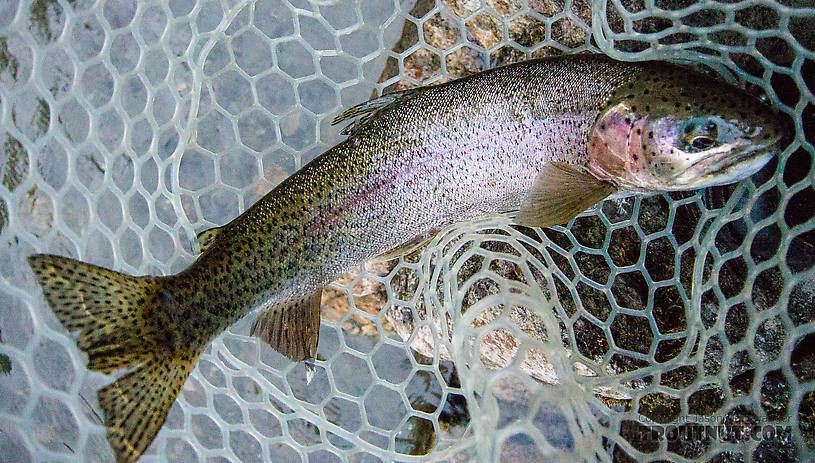
We fished until close to midnight. But the action was only getting started -- see Part II.
Various government brochures speak of a six-mile trail, the Haggard Creek Trail, leading from the Richardson Highway to this spot on the river, Canyon Rapids, a half-mile of raging Class III-IV whitewater that most floaters have to portage, or at least portage their gear and run with empty boats. One online source warned that the trail can be "a bit swampy," so I warned Josh with that caveat -- "It might be a bit swampy."
This video of the trip shows what they meant by that (and the fishing afterward):
Yeah, just a bit swampy.

To be fair, the lakes were actually to the side of the trail. This was the actual trail:

This, too:

The mosquitoes were as bad as I've ever seen them anywhere in Alaska except the North Slope. This was typical:

Most of the trail was hard to even find, let alone follow. It's really a winter trail. In the summer it's mostly untracked bog, with the "trail" frequently opening up into larger boggy meadows in which the trail's exit is unclear and no walkable route is apparent. I relied on coarse aerial imagery on my GPS to let me know when we'd wandered too far from the supposed trail in one direction or another. It reminded me of the scene below, but with trout at the end instead of Mordor. And my guide kept quiet instead of coughing out, "Garmin! Garmin!"

After five hours in the swamp, the sound of running water was a great relief, followed by this view:

We set up camp at one of the nice campsites used by the heavy raft traffic ("heavy" means at least a few parties per day here):

Then got to fishing the whitewater:


When we began fishing mid-evening, fishing nymphs under indicators, we mostly just caught small 10-15" grayling. Dozens of them. Fish on every cast at times. But there was little sign of the big rainbows we came for. The nymphs just picked up some little ones, like this:

There were a lot of seagulls around, and I watched them as I fished, curious about why they were here. There were salmon in the river, both reds and kings, but we didn't see many, and no dead ones yet for the seagulls to peck at. What drew them to this spot?

After a while I figured out the gulls, and with them, the rainbows. Finger-length sockeye salmon smolts were outmigrating from Paxson Lake upstream. When they hit the roiling whitewater of the canyon, some of them got momentarily disoriented and boiled up to the surface. That's when the gulls would swoop down and grab them. I figured the rainbows, which had been largely ignoring our nymphs, might be doing something similar. So I put on a silvery streamer and the real fun began.



We fished until close to midnight. But the action was only getting started -- see Part II.
Photos by Troutnut from the Gulkana River in Alaska
Friend's family starting a Kenai River fishing guide service
My friend and fieldwork crew member Sierra comes from a rural Alaskan family with a strong angling tradition, and they've been spending summers on the Kenai River for a long time. Several times last summer she returned from the long breaks between our research trips describing what fun she had fishing the Kenai for trout and salmon with her family. This year, her dad is starting up a new guiding business: Corsetti's Kenai River Guide Service.
I'm hoping to get down there myself summer. If any Troutnut readers are thinking of heading to Alaska anytime soon, give him a call -- I think you'll have a great experience. His rates are better than what I've paid in the past on the Kenai River, and you'll be fishing with the head guide who has lived in the area and built up many years of experience on the river.
I'm hoping to get down there myself summer. If any Troutnut readers are thinking of heading to Alaska anytime soon, give him a call -- I think you'll have a great experience. His rates are better than what I've paid in the past on the Kenai River, and you'll be fishing with the head guide who has lived in the area and built up many years of experience on the river.
Some animations on how fish react to prey
Where do you need to put the fly to catch a trout?
Countless books about fly fishing contain whole chapters on this subject, but a couple of the main lessons are (1) get the fly down to the fish's level, if you're fishing subsurface, and (2) cast upstream of the fish, not right over its head.
Thanks to the hard work of my labmates at the University of Georgia building detailed datasets for the Drift Model Project, I was able to construct some 3-D animation videos showing where drift-feeding fish, such as trout, detect their prey. We're using these data to test models that predict how much energy the fish are gaining and how that depends on aspects of their habitat such as water velocity and drifting prey. Those models will eventually help us better predict the effects of habitat modifications and changing streamflow patterns on trout and other drift-feeding fish. We're far from done crunching all the numbers from last summer's data collection, but some of our intermediate results may be interesting to fly anglers.
A few key videos are embedded below, but the full set is available as a playlist on the Drift Model Project's Youtube channel.
The videos rotate around an animated fish representing either an Arctic grayling (14-19 inches long), dolly varden (6-8 inches long), or juvenile Chinook salmon (about 3 inches long). The yellow dots show the estimated positions of potential prey items (some real prey, some inedible debris) at the moment when the fish reacted to them. All the positions are shown relative to the position of the fish, which is shown facing straight upstream.
Here's one from a smallish (~14-inch) Arctic grayling during a moderately thick Cinygmula hatch:
Note the separate layer of detection positions on the top, all of which were prey taken from the water's surface (not quite in an even plane because of small measurement errors). Some goes for the following 19-inch grayling feeding during a Drunella doddsii hatch:
And here's a 7-inch dolly varden feeding without any particular hatch:
And a juvenile Chinook salmon:
Obviously this is a limited sample. We're continually expanding it, but even then we're only studying three species at the moment. So don't be surprised if you've seen some things that don't fit these patterns. Nevertheless, they give me reason to speculate a few possible insights into fly fishing:
First, the fish react most often to subsurface prey that drift really close to them. So there's probably a huge payoff for very accurate fly placement, especially when you're sight fishing with a subsurface fly. Getting down to the fish's level is clearly critical, but so is placing the fly laterally so it passes right by the fish.
Second, even though the grayling were surface feeding on hatches, they continued to take a lot more subsurface prey throughout the time we observed them. These fish seemed to be picky about what they took from the surface, judging by what flies they would accept when we caught them later to (harmlessly) pump their stomachs. Yet despite that apparent selectivity on the surface, they were pursuing and capturing a variety of items below the surface. Nymph aficionados, some of whom prefer to fish a nymph straight through a hatch and a good rise of fish, may rejoice at this news. But not so fast, because...
Third, the fish react to prey on the surface from much farther away than they react to subsurface prey, perhaps because it better stands out against the background. This explains why dry flies work so well, and it offers the dry fly angler a defense against the nympher who insists that it's better to fish subsurface because that's where the fish get most of their food. It's true that there's rarely a better way to entice a fish than to present a nymph on a perfect, accurate drift. But it can take most of us several tries to get that perfect subsurface presentation, especially if we don't know exactly where the fish is. When trying to just read the water and guess where fish might be, it makes a lot of sense to use a dry, because every cast effectively covers a lot more ground. Even when we're working a particular rising fish that would be receptive to a nymph or dry, it's easier to consistently cast a dry into the strike zone than a nymph.
Finally, I want to emphasize again that these are just my preliminary thoughts as an angler after seeing the data we've analyzed so far on this project. They are not conclusive scientific findings. But they are good food for thought.
Countless books about fly fishing contain whole chapters on this subject, but a couple of the main lessons are (1) get the fly down to the fish's level, if you're fishing subsurface, and (2) cast upstream of the fish, not right over its head.
Thanks to the hard work of my labmates at the University of Georgia building detailed datasets for the Drift Model Project, I was able to construct some 3-D animation videos showing where drift-feeding fish, such as trout, detect their prey. We're using these data to test models that predict how much energy the fish are gaining and how that depends on aspects of their habitat such as water velocity and drifting prey. Those models will eventually help us better predict the effects of habitat modifications and changing streamflow patterns on trout and other drift-feeding fish. We're far from done crunching all the numbers from last summer's data collection, but some of our intermediate results may be interesting to fly anglers.
A few key videos are embedded below, but the full set is available as a playlist on the Drift Model Project's Youtube channel.
The videos rotate around an animated fish representing either an Arctic grayling (14-19 inches long), dolly varden (6-8 inches long), or juvenile Chinook salmon (about 3 inches long). The yellow dots show the estimated positions of potential prey items (some real prey, some inedible debris) at the moment when the fish reacted to them. All the positions are shown relative to the position of the fish, which is shown facing straight upstream.
Here's one from a smallish (~14-inch) Arctic grayling during a moderately thick Cinygmula hatch:
Note the separate layer of detection positions on the top, all of which were prey taken from the water's surface (not quite in an even plane because of small measurement errors). Some goes for the following 19-inch grayling feeding during a Drunella doddsii hatch:
And here's a 7-inch dolly varden feeding without any particular hatch:
And a juvenile Chinook salmon:
Obviously this is a limited sample. We're continually expanding it, but even then we're only studying three species at the moment. So don't be surprised if you've seen some things that don't fit these patterns. Nevertheless, they give me reason to speculate a few possible insights into fly fishing:
First, the fish react most often to subsurface prey that drift really close to them. So there's probably a huge payoff for very accurate fly placement, especially when you're sight fishing with a subsurface fly. Getting down to the fish's level is clearly critical, but so is placing the fly laterally so it passes right by the fish.
Second, even though the grayling were surface feeding on hatches, they continued to take a lot more subsurface prey throughout the time we observed them. These fish seemed to be picky about what they took from the surface, judging by what flies they would accept when we caught them later to (harmlessly) pump their stomachs. Yet despite that apparent selectivity on the surface, they were pursuing and capturing a variety of items below the surface. Nymph aficionados, some of whom prefer to fish a nymph straight through a hatch and a good rise of fish, may rejoice at this news. But not so fast, because...
Third, the fish react to prey on the surface from much farther away than they react to subsurface prey, perhaps because it better stands out against the background. This explains why dry flies work so well, and it offers the dry fly angler a defense against the nympher who insists that it's better to fish subsurface because that's where the fish get most of their food. It's true that there's rarely a better way to entice a fish than to present a nymph on a perfect, accurate drift. But it can take most of us several tries to get that perfect subsurface presentation, especially if we don't know exactly where the fish is. When trying to just read the water and guess where fish might be, it makes a lot of sense to use a dry, because every cast effectively covers a lot more ground. Even when we're working a particular rising fish that would be receptive to a nymph or dry, it's easier to consistently cast a dry into the strike zone than a nymph.
Finally, I want to emphasize again that these are just my preliminary thoughts as an angler after seeing the data we've analyzed so far on this project. They are not conclusive scientific findings. But they are good food for thought.
Top 10 Fly Hatches
Top Gift Shop Designs
Eat mayflies.
Top Insect Specimens
Miscellaneous Sites
Troutnut.com is copyright © 2004-2024 Jason
Neuswanger (email Jason). See my FAQ for information about use of my images.
 privacy policy
privacy policy

